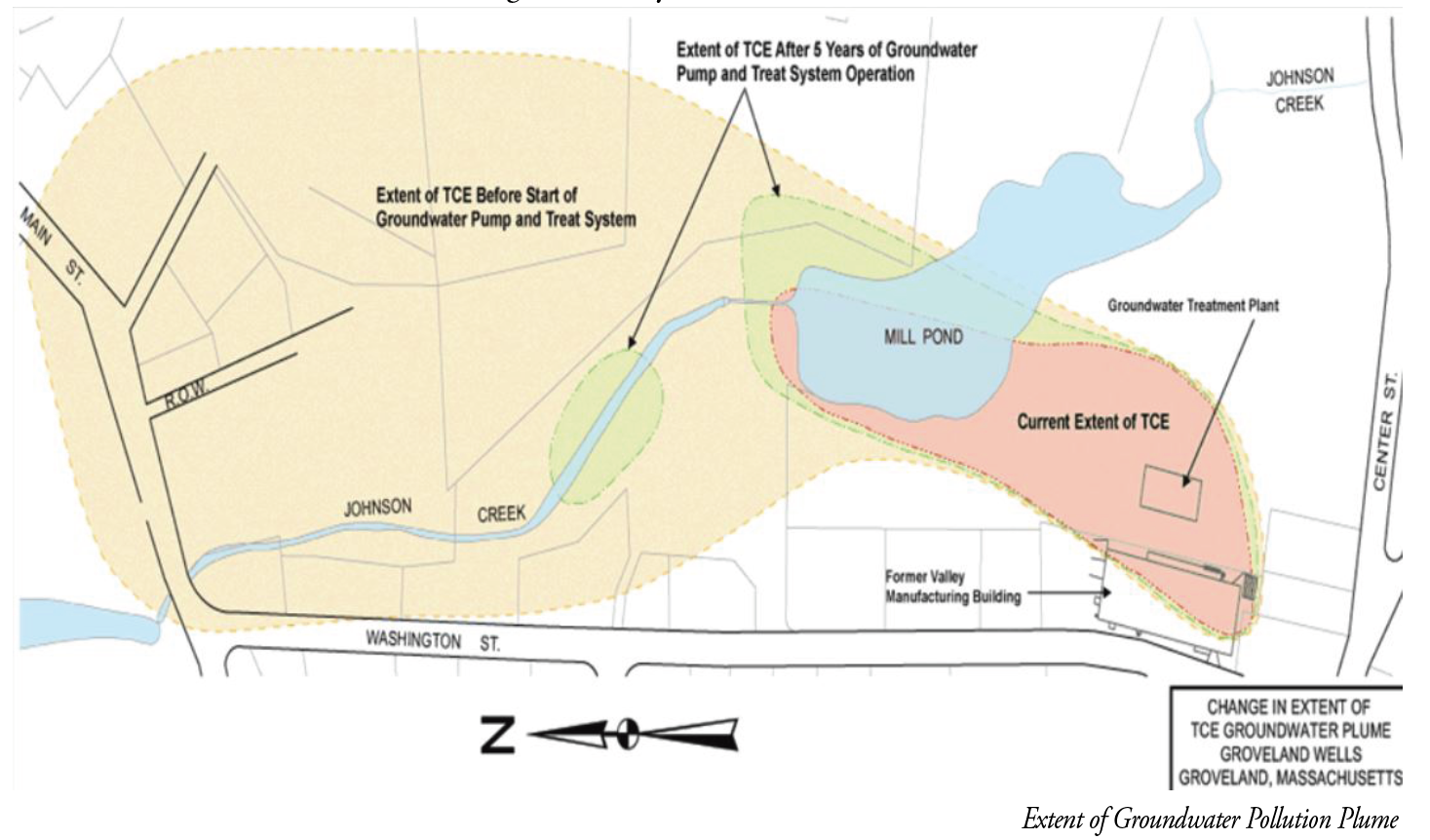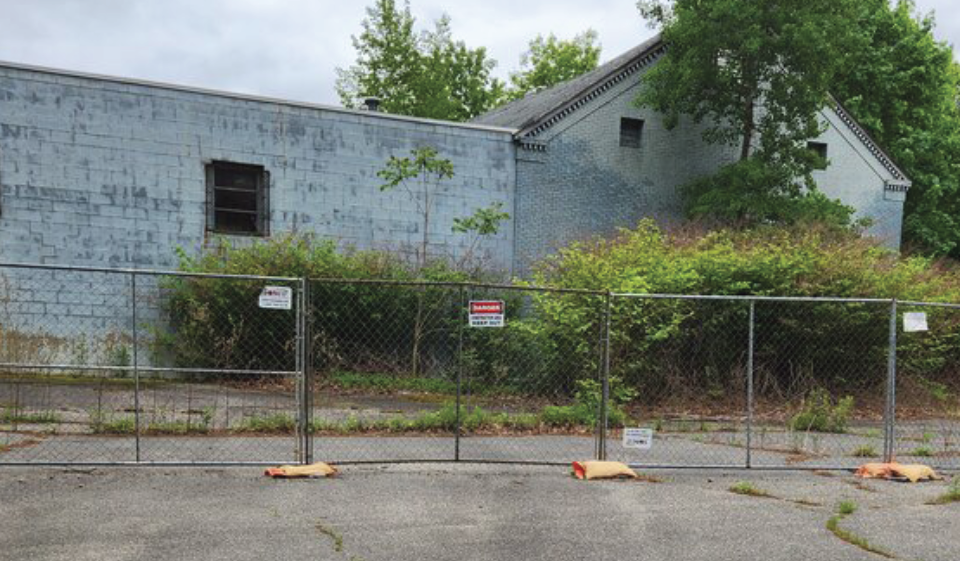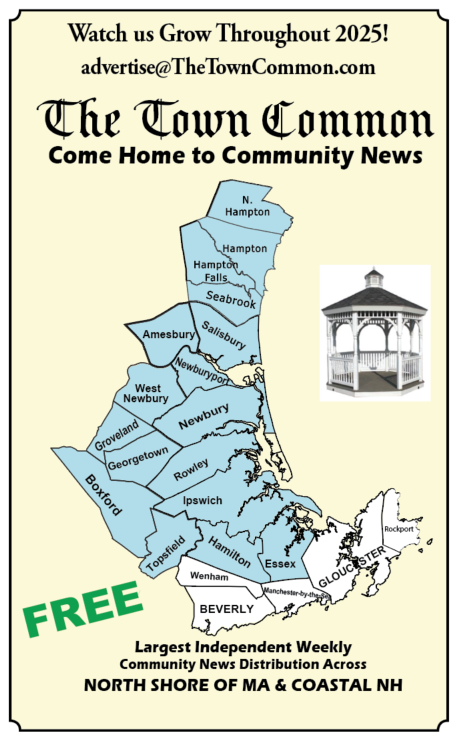GROVELAND: Valley Manufactured Products Well Contamination Part 1 How did it happen?
By Michael Dempsey
Special to The Town Common
Love Canal, one of the worst environmental disasters in this country became known in 1978. As a result of over 12,000 chemical and hazardous waste sites in the country, Congress passed, and President Carter signed the Superfund law in December of 1980. Until then the government had no way to deal with all the ongoing contamination nationwide. This had an impact even here in Groveland.
The abandoned building we are all familiar with located at 64 Washington Street was built as a storehouse for the woolen mills owned by Arthur Veasey in the 1920’s. A similar building was once located across the street where the Madison Avenue development is. When the mills were closed in the 1940’s the many brick buildings behind 46 Washington Street were torn down. 46 Washington Street is the last remaining brick mill building. Eventually the Madison Avenue building was removed and the site sold to developers leaving the last storehouse standing unused for several years. In 1963 local entrepreneurs bought the building and opened a machine shop where metal parts, screws, and cable connectors were made. The company, later known as Valley Manufactured Products, operated in the building from 1963 until it closed in 2001.
In 1979 during routine annual water
testing of the Groveland wells by the Massachusetts Department of Environmental Quality Engineering, now known as Mass DEP, hazardous substances were identified in the water. Further testing identified levels of chemicals Trichloroethylene, Methyl Chloride and Arsenic in the water. At that point the two polluted wells in South Groveland, #1 and #2 were shut down. Now we had a real problem, beyond figuring out where the contamination came from, we had to find a new source of drinking water.
As test wells placed upstream from the wells continued to reveal increased levels of the chemicals in the water, the Board of Health put together a Well Protection Committee to investigate the cause and determine a solution. The committee consisted of 5 town leaders including John Osborne who became the chair and chief negotiator. Test results indicated that the potential sources of contamination seemed to be two other companies on Salem Street and the Valley Manufactured Products plant. The committee began negotiations with the companies, however, with more testing the Valley Manufactured Products plant seemed to be the largest contributor to the contamination. In 1980 Valley offered the town $60,000 to clean up the chemicals but the committee wouldn’t hear of it and took all three potential polluters to court. After an 11-year effort, the companies finally settled with the town for $1 million dollars. Once the lawyers were paid, the town used the remaining funds to develop a new well, #4, located along the Merrimack River behind the cemetery.
Meanwhile, after much investigation by the EPA an Administrative Order by Consent was issued by them. The US EPA docket number 1-87-1091 AOC, is a legal document issued by the EPA that requires a party to take specific actions to address environmental concerns. It’s essentially a settlement agreement where the EPA and the regulated entity agree on the steps needed to resolve a violation of environmental law. The Order was signed on September 3rd and 4th by the EPA and Thomas Quinlan, President of the Valley Manufactured Products.
Small machine shops like Valley Manufactured Products often make small metal parts. Once the parts are cut, they require chemical treatments to clean them of the oil used in the process. Trichloroethylene, a known carcinogen, was the cleaner of choice. Often the parts would later be brightened in an acid bath. When the chemical’s ability to clean was finished they had to be disposed of as waste and a hauler paid to take them away. Valley had used these processes at their plant.
The document which was obtained at the Langley Adams Library and is also available on the EPA Web Site contains a section called Statements of Fact. This section details operations and activities at the site from 1963 until 1985. The common belief is the hazardous chemical contamination came as the result of the accidental release of waste trichloroethylene dumped into a tank that had been improperly installed in the ground without a drain plug. However, the statement of facts signed by the owner reveals much more egregious behaviors by the company. Here are a few examples.
Between 1964 and 1972 and possibly as late as 1974 the company released at least twenty gallons of waste oil containing other hazardous substances each month onto the ground at the southern end of the existing building.
Between 1964 and 1966 and possibly as late as 1972 the company released at least three to four fifty-five-gallon drums of waste oil containing trichlorethylene or other hazardous substances each year as a defoliant on the eastern side of the building and in the area where the parking lot is located.
Between 1970 and 1979 the acid bath process was located on an earthen floor in the basement near the compressor room and the company discharged wastewater from this process into the parking lot.
These activities caused the chemicals to seep into the ground and pollute our two nearby wells.

There was no doubt that what the company did to dispose of their waste was no accident. At the time, these activities placed at least 160 nearby residents health at risk and endangered adults and children who drank the water.
No studies were ever done to measure the effect on Groveland residents.
We will never know the full impact of this behavior practiced by the Valley Manufactured Products Company to rid themselves of chemical waste to save money.
Eventually the company shut down all operations in Groveland and closed. The building was abandoned and left to fall apart. The company and owner pay no taxes on the building and our town is forced to set aside funds every year to cover the unpaid taxes, plus fees, interest, and penalties. This is done because Massachusetts law requires it.
In the next segment we will hear about how the EPA Superfund program cleaned up the site and well #1, and the restrictions we are still living with on nearby properties. Finally, we’ll learn what the future holds to free us of the awful specter of that collapsing building on Washington Street. ♦




